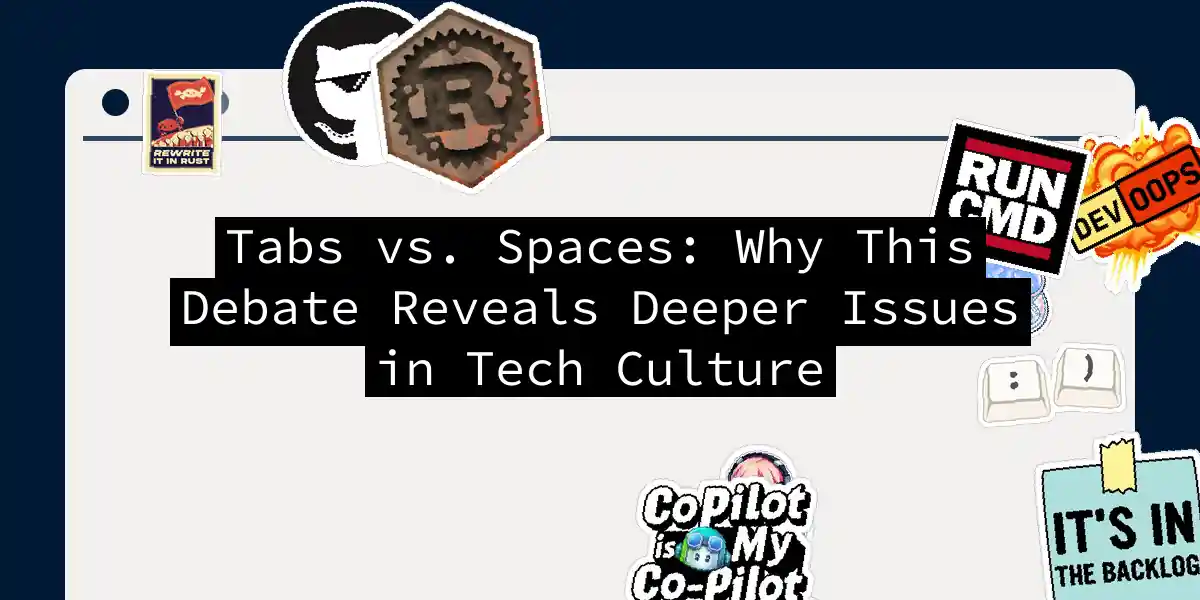The debate over whether to use tabs or spaces for indentation in code is one of the most enduring and contentious issues in the tech community. It’s a battle that has been waged for decades, with each side presenting compelling arguments. But beneath the surface of this seemingly trivial dispute lies a complex web of issues that reflect deeper aspects of tech culture, including collaboration, personal preference, and the philosophy of coding.
The Lexical Argument: Tabs Were Meant for Indentation
One of the strongest arguments in favor of using tabs is rooted in their original purpose. Tabs were literally invented for indentation, while spaces are meant for spacing between words and other elements[1].
When you use tabs for indentation, you leverage their inherent flexibility. Users can adjust the tab width in their editors to suit their preferences, ensuring that the code looks consistent and readable to them. This flexibility is a boon for collaboration, as it allows team members to work with the same codebase without the need for constant reformatting. For instance, if one developer prefers a tab width of four characters and another prefers eight, both can configure their editors accordingly without altering the underlying code.
The Practical Benefits of Tabs
Using tabs also offers several practical advantages. Here are a few key points:
- Fewer Key Presses: With tabs, you need to press the tab key only once to indent, as opposed to pressing the space bar multiple times. This reduces the effort required to write and maintain code.
- Smaller File Sizes: Since tabs are single characters, they result in smaller file sizes compared to using multiple spaces. This can be significant, especially in web development where smaller files mean faster download times and quicker parsing times for both interpreted and compiled languages[1].
- Easier Error Detection: Misindentation errors are more obvious with tabs because they typically involve a full tab width, making them easier to spot than single-space errors[1].
The Consistency Argument: Spaces Ensure Uniformity
On the other hand, proponents of spaces argue that consistency is key. One of the main concerns with tabs is that different platforms and editors display them with varying widths, which can lead to inconsistent formatting when code is shared or viewed on different systems[3].
Using spaces ensures that the code looks the same everywhere, as a space is always a space regardless of the platform or editor settings. This consistency is particularly important in collaborative environments where code is frequently shared and reviewed.
The Philosophical Divide: Whose Responsibility is Indentation?
The debate between tabs and spaces is not just technical; it’s also philosophical. It boils down to whose responsibility it is to specify indentation: the writer of the code or the reader.
Tabs supporters argue that indentation should be left to the reader’s preference, allowing them to configure their editors to display the code in a way that makes the most sense to them. This approach emphasizes flexibility and personal preference.
On the other hand, spaces advocates believe that the writer of the code should specify the indentation explicitly to ensure consistency and clarity. This approach prioritizes the intent of the code author and the readability of the codebase[3].
The Impact on Collaboration and Culture
The tabs vs spaces debate also reflects broader issues in tech culture, particularly around collaboration and coding standards.
In many organizations, coding standards are mandated to ensure consistency across the codebase. However, these standards are often based on personal preferences or historical practices rather than a thorough consideration of the benefits and drawbacks of each approach. For instance, some coding standards might require the use of spaces simply because it has always been done that way, without considering the advantages of tabs[1].
This highlights a larger issue in tech culture: the tendency to follow established practices without questioning their validity. It also underscores the importance of open discussion and continuous improvement in coding practices.
Economic and Social Implications
Interestingly, research has suggested that the choice between tabs and spaces might even have economic implications. A study found that programmers who use spaces instead of tabs tend to earn more, although this correlation does not necessarily imply causation[4].
While this finding is intriguing, it’s more likely a reflection of broader trends in the industry rather than a direct result of the indentation method used. However, it does suggest that the choice between tabs and spaces might be tied to other aspects of coding culture and professional practices.
Conclusion and Call to Action
The debate over tabs vs spaces is far from trivial. It touches on fundamental aspects of coding culture, including collaboration, personal preference, and the philosophy of coding.
Whether you are a staunch supporter of tabs or a devoted user of spaces, it’s important to understand the arguments on both sides and to approach this issue with an open mind. Here are some steps you can take to contribute to a more nuanced discussion:
- Experiment with Both: Try using both tabs and spaces in your coding projects to see which works better for you and your team.
- Discuss and Debate: Engage in open discussions with your colleagues about the pros and cons of each approach.
- Consider Flexibility: Think about how your choice affects collaboration and readability, and be willing to adapt based on the needs of your project.
By doing so, we can move beyond the superficial debate and delve into the deeper issues that shape our coding practices and tech culture as a whole.
